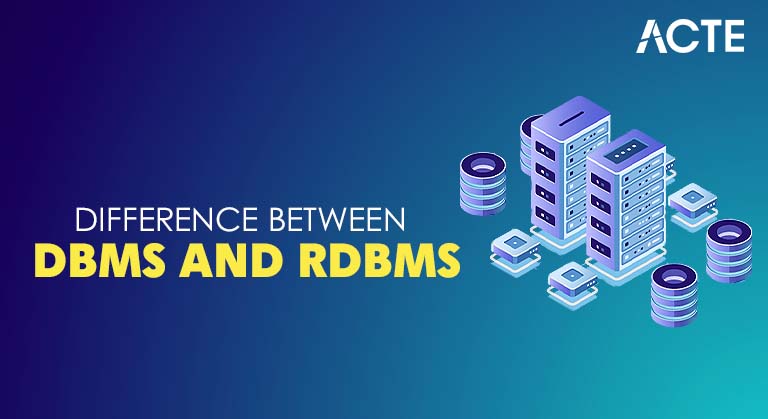
- Introduction
- What is DBMS?
- What is RDBMS?
- Data Storage Comparison
- Data Integrity
- Schema and Structure
- Query Language Support
- Transactions and ACID
- Examples of Each
- Use Case Suitability
- Conclusion and Future Trends
Introduction
In today’s digital age, data is the foundation of decision-making, operations, and strategic planning. Managing this data effectively is crucial, and two major technologies enable this: Database Management Systems (DBMS) and Relational Database Management Systems (RDBMS). Database Training clarifies common misconceptions by distinguishing between similar terms. Although these terms are often used interchangeably, they serve different purposes and offer different functionalities. This guide provides a deep dive into what makes DBMS and RDBMS unique, their architectures, capabilities, and how they are used across industries.
What is DBMS?
A Database Management System (DBMS) is software designed to store, manage, and retrieve data in a structured way. It allows users to perform basic operations such as storing data, retrieving it, updating information, and deleting records. DBMS abstracts data from the user and provides a consistent way to interact with it. The database landscape is changing quickly. RDBMS sellers are cleverly responding to new technology trends. Cloud integration has become an important focus.

This allows for distributed database solutions that provide more scalability and flexibility. At the same time, artificial intelligence and machine learning are changing how we manage the database. They do this through a smart query optimizer, which improves performance and efficiency. The industry is moving towards hybrid database architecture. These combine relationships and unrelated characteristics, allowing organizations to manage data in a more flexible manner. Additionally, the open-source movement keeps gaining strength. Community-intensive platforms such as PostgreSQL and MariaDB are showing impressive innovation and teamwork. This eventually makes advanced database technologies more accessible and provides a strong option for traditional ownership solutions.
Interested in Obtaining Your Data Science Certificate? View The Data Science Online Training Offered By ACTE Right Now!
What is RDBMS?
A Relational Database Management System (RDBMS) is a type of DBMS that organizes data into related tables. It adheres to the relational model proposed by E.F. Codd. Tables are linked via keys (primary and foreign), which enables complex queries and ensures data integrity. Relative database management systems (RDBMS) provide a strong and organized way to store and manage data. Database Training introduces the structured nature of data systems. These systems arrange information in tables, using rows and columns to keep data organized. They also support SQL, which helps to quarry and manipulate the data efficiently. Acid compliance ensures that transactions are reliable, maintain data integrity and stability even during complex functions. The scheme enforcement mechanism holds a strict structure, defining the relationship with specific data types and relationships involved in foreign key and operation. Prominent examples of RDBMS include Oracle database, MySQL, Microsoft SQL server, Postgresql and IBM DB2. Each of these provides powerful data management equipment for various organizational requirements.
To Explore Data Science in Depth, Check Out Our Comprehensive Data Science Online Training To Gain Insights From Our Experts!
Data Storage Comparison
DBMS:
- Uses flat-file storage.
- Limited indexing and data searching.
- Minimal support for complex data relationships.
- Suitable for local or standalone applications.
- Stores data in structured, interrelated tables.
- Provides efficient indexing and querying.
- Supports large-scale, multi-user environments.
RDBMS:
Verdict: RDBMS offers more structured and scalable data storage options.
Data Integrity
Smart Ways to Learning includes a comparison of data integrity between DBMS and RDBMS. While both systems aim to maintain data accuracy and consistency, RDBMS enforces stricter integrity constraints through relational rules, primary keys, and foreign keys. DBMS offers flexibility but may require additional logic to ensure integrity across diverse data models.
DBMS:
- Does not enforce strong data integrity.
- Relationships are managed at the application level.
- More prone to data redundancy and inconsistency.
- Enforces data integrity using constraints (primary, foreign keys).
- Supports normalization to avoid redundancy.
- Maintains consistency even with concurrent access.
RDBMS:
Impact: RDBMS is superior in maintaining data integrity.
Gain Your Master’s Certification in Data Science Training by Enrolling in Our Data Science Master Program Training Course Now!
Schema and Structure
DIn the database management system (DBMS), the way the scheme and structures are handled, it is quite different between the traditional DBMS and the Relational Database Management System (RDBMS). Database Training explores the contrasting models of DBMS and RDBMS. Traditional DBMS allows for flexible, alternative schema and supports hierarchical or network data models. On the other hand, RDBMS takes a strict approach. The relational database requires predetermined schema and a clear tabular format, which creates a more consistent and organized environment. This structured method makes RDBMS good for particularly complex applications that require accurate data organizations, predicted relations and strong integrity rules. The main difference is the balance between flexibility and structure, RDBMS focuses on data stability and reliability rather than skimps optimization.
Are You Preparing for Data Science Jobs? Check Out ACTE’s Data Science Interview Questions and Answers to Boost Your Preparation!
Query Language Support
When comparing the database management systems (DBMS) and relational database management systems (RDBMS), query language support stands as a significant difference. Traditional DBMs often use proprietary query interfaces that have limited or no SQL support. This limits their operational flexibility.

On the other hand, RDBMS provides complete SQL capabilities and fully supports queries, updates, and transactions. These SQL features include complex functions such as sub-region, visual, and stored procedures. This makes RDBMS more functional and user-friendly. The strong query language structure allows for advanced data manipulation, making RDBMS a better option for organizations that require effective database management and detailed data interaction strategies.
Transactions and ACID Compliance
- Atomicity: Ensures complete success or failure of transactions.
- Consistency: Ensures data meets all constraints.
- Durability: Data changes persist even after failures.
DBMS vs RDBMS ACID Compliance:
DBMS:
- May lack complete ACID compliance.
- Not ideal for critical transaction processing.
- Fully supports ACID.
- Reliable for mission-critical operations.
RDBMS:
MongoDB vs SQL comparisons often highlight differences in isolation levels. SQL databases typically support full ACID compliance, offering strict isolation through mechanisms like locking and multi-version concurrency control. MongoDB, while improving its transactional capabilities, provides more relaxed isolation suited for high-throughput operations, especially in distributed environments.
Examples of Each
DBMS Components:
- Database Engine: Manages data access.
- Query Processor: Handles user commands.
- Data Dictionary: Metadata repository.
- Application Interface: User interface for DBMS interaction.
RDBMS Additional Components:
- Relational Engine: Manages relational tables.
- Transaction Manager: Ensures ACID compliance.
- Optimizer: Enhances query performance.
Architecture Comparison:
DBMS:
- Often single-tier architecture.
- Applications directly access the database.
- Supports client-server and three-tier architecture.
- Enables better scalability and security.
RDBMS:
Summary: RDBMS architecture is more suited for enterprise environments.
Use Case Suitability
Database Management System (DBMS) and Relative Database Management System (RDBMS) serve various objectives in various technology settings. DBMS works well for simple individual or departmental applications and small embedded systems. In contrast, RDBMS is better for large enterprise challenges. Enterprise Data Strategy highlights how RDBMS shines in complex environments such as banking and e-commerce, providing strong performance in multi-user cloud setups. The main difference is scalability. RDBMS can handle high-volume and complex applications that require advanced data management and processing. The outfits seeking flexible database solutions will be useful to meet especially complex operating requirements and support the changing technology environment.
Future Trends and Conclusion
Both DBMS and RDBMS are vital in the realm of data storage and retrieval, but they serve different needs. DBMS is suitable for small-scale, single-user applications that don’t require relational data structuring. On the other hand, RDBMS is designed for robust, multi-user environments demanding high data integrity, ACID compliance, and complex query support. With modern applications becoming more data-centric, RDBMS has become the standard in most industries. It not only enforces data integrity and consistency but also supports high concurrency, reliability, and scalability. The database landscape is changing quickly. Database Training highlights how RDBMS sellers are cleverly responding to new technology trends. Cloud integration has become an important focus. This allows for distributed database solutions that provide more scalability and flexibility. At the same time, artificial intelligence and machine learning are changing how we manage the database. They do this through a smart query optimizer, which improves performance and efficiency. The industry is moving towards hybrid database architecture. These combine the relationship and non-related characteristics, allowing organizations to manage data in a more flexible manner. Additionally, the open-source movement keeps gaining strength. Community-intensive platforms such as PostgreSQL and MariaDB are showing impressive innovation and teamwork. This eventually makes advanced database technologies more accessible and provides strong options for traditional proprietary solutions.


